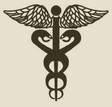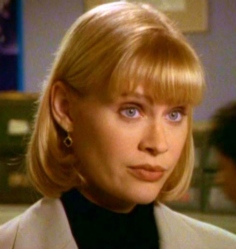
This episode began in December 1998, when I was suffering from the worst cold I think I have ever had in my life. In fact, my mother said she thought I had pneumonia; and, although at the time I pooh-poohed it, retrospectively I think she may have been right. Certainly, at one point, I went for thirty-six hours without any sleep because every time I started to relax, my lungs filled up to the point where I had to sit up and cough phlegm to try to clear them a bit. Over two weeks, I used up four boxes of Kleenex—and two of them were double-sized boxes.
In the middle of this, when I was shifting from bed to sofa and back again, I watched an episode of Star Trek: Voyager that got me thinking.
 It presented the ship’s holographic Doctor with an ethical dilemma: B'Elanna Torres had been infected, and the only way to cure her was with the aid of a holodeck program based on a Cardassian war criminal who had been guilty of using prisoners as experimental guinea pigs. B’Elanna did not want this; she wanted the program deleted. But the Doctor felt that, ethically, it would be wrong to let her die if the information to save her existed, even in a form she found unpalatable. Nevertheless, having used the program to save her life, he then decided to accede to her wishes and delete it from the ship’s data base. My immediate reaction was to wonder how some other crew member would feel, a year or so later, if they were injured or infected in such a way that the information in the now-deleted program could have saved them. “I’m sorry, there’s nothing I can do,” the Doctor would tell them. “But isn’t this the same thing Lt. Torres had last year?”, the poor guy would respond. “Can’t you save me the same way you did her?” “Oh, no,” the Doctor would say cheerfully, “I decided she was right about the unethical nature of the data, and I deleted it. I know you’ll agree this was the right thing to do. You’ll just have to die.”
It presented the ship’s holographic Doctor with an ethical dilemma: B'Elanna Torres had been infected, and the only way to cure her was with the aid of a holodeck program based on a Cardassian war criminal who had been guilty of using prisoners as experimental guinea pigs. B’Elanna did not want this; she wanted the program deleted. But the Doctor felt that, ethically, it would be wrong to let her die if the information to save her existed, even in a form she found unpalatable. Nevertheless, having used the program to save her life, he then decided to accede to her wishes and delete it from the ship’s data base. My immediate reaction was to wonder how some other crew member would feel, a year or so later, if they were injured or infected in such a way that the information in the now-deleted program could have saved them. “I’m sorry, there’s nothing I can do,” the Doctor would tell them. “But isn’t this the same thing Lt. Torres had last year?”, the poor guy would respond. “Can’t you save me the same way you did her?” “Oh, no,” the Doctor would say cheerfully, “I decided she was right about the unethical nature of the data, and I deleted it. I know you’ll agree this was the right thing to do. You’ll just have to die.”
You see, one of the problems with dealing with anything related to mass murder—whether it’s an actual genocide or just a fictional one—is that the ethical issues get obscured by the sheer numbers of dead. People simply cannot think clearly when the corpses pile up in the millions.
So I thought: suppose the same ethical dilemma (in principle) were applied to a small-scale situation—would the ethics be clear in that case?

What sort of “wrong” could be done to one victim in such a way as to make it possible to save some other person? Critically, the person to be saved would have to be innocent of the wrong (as, in the Voyager episode, B’Elanna had had nothing to do with the Cardassian medical experiments).
Organ transplants came to mind. In some cases, the life of the
recipient depends on the death of the donor: certainly that is true of heart transplants.
 Suppose the donor were not an accident victim, as is most usual in Canada, but were instead a murder victim? Then the life of the recipient would be dependent on the actions of a murderer. Someone would have to die, and die at the hands of another, in order for them to be saved. Should the organ be used in that case? Is it unethical to use the organs of murder victims? Or would it be ridiculously wasteful not to use their organs, if a transplant would save the life of someone else. Surely two deaths cannot be better than one? To squeeze the dilemma tighter, I made the murderer and recipient related—with the recipient still having no idea that murder was done for them.
Suppose the donor were not an accident victim, as is most usual in Canada, but were instead a murder victim? Then the life of the recipient would be dependent on the actions of a murderer. Someone would have to die, and die at the hands of another, in order for them to be saved. Should the organ be used in that case? Is it unethical to use the organs of murder victims? Or would it be ridiculously wasteful not to use their organs, if a transplant would save the life of someone else. Surely two deaths cannot be better than one? To squeeze the dilemma tighter, I made the murderer and recipient related—with the recipient still having no idea that murder was done for them.

That, in the event, this philosophical issue was relegated to the Epilogue is the sort of thing that happens all too often. Something similar occurred with “Walk Out Once More Beneath the Sun”, if you remember. For of course, as soon as the idea of organ transplants came into my mind, so did the Forever Knight episode, “Let No Man Tear
Asunder7rdquo;, which involved a black market in stolen human organs.
 I had not cared for the episode. Indeed, in the first half of Season III, which I otherwise thought enthralling,
this was the only low point. It was dependent on a quite ridiculous number of coincidences to make the plot work. And the revelation that Tracy had an uncle needing a heart transplant, which should have been the emotional center of the episode, was relegated to nothing more than a plot device to get her off on her own following up her own leads, with the spurious possibility that she would buy her uncle a heart instead of arresting the murderers.
I had not cared for the episode. Indeed, in the first half of Season III, which I otherwise thought enthralling,
this was the only low point. It was dependent on a quite ridiculous number of coincidences to make the plot work. And the revelation that Tracy had an uncle needing a heart transplant, which should have been the emotional center of the episode, was relegated to nothing more than a plot device to get her off on her own following up her own leads, with the spurious possibility that she would buy her uncle a heart instead of arresting the murderers.
But what if I took the idea and wrote it right?

The episode was not actually written until January 1999, since I had to recover from my cold (or pneumonia), and then from the second cold that I caught a week later. As a result, when I did finally write it, it was so clearly organized in all its details in my head that it just poured out from start to finish in less than a week. Granted I needed to polish it a bit; but very little compared with most episodes.
Because of the number of plot lines that I had to fit in, the organization of the episode was critical to its comprehensibility. You will note that Acts One, Three, and Five concentrate on the murder case, while the scenes with Tracy’s relatives at the hospital are in Acts Two and Four; and each act ends with a tiny scene that reminds you of what you've not had in that act—but will be getting in the next one. It’s a little dance.
There’s a “dance7rdquo; to plotting out a season, too. When I came to write the episode, “Death Shall Be No More”, I deliberately inserted a reference to Uncle Sonny’s heart condition so that the character would not appear to come out of the blue when he goes to hospital in this episode. Indeed, that is the reason—the only reason—why I made David Murray (the guy whose frozen body was stolen) die of a heart attack rather than something else: so that I would appear to have a reason to introduce Uncle Sonny.

“Broken Hearts” was written about two months before my father’s death. Although this was unexpected, since we had not known he had cancer, it had been obvious for some time that he was becoming increasingly frail. Tracy’s emotions are more immediate than mine were at the time I was writing, because she is aware that her uncle’s death is imminent. (I didn’t have that long, long night until late in March.) But I was already all too familiar with that sword-of-Damocles sensation of waiting for the dreaded inevitable.
|
|